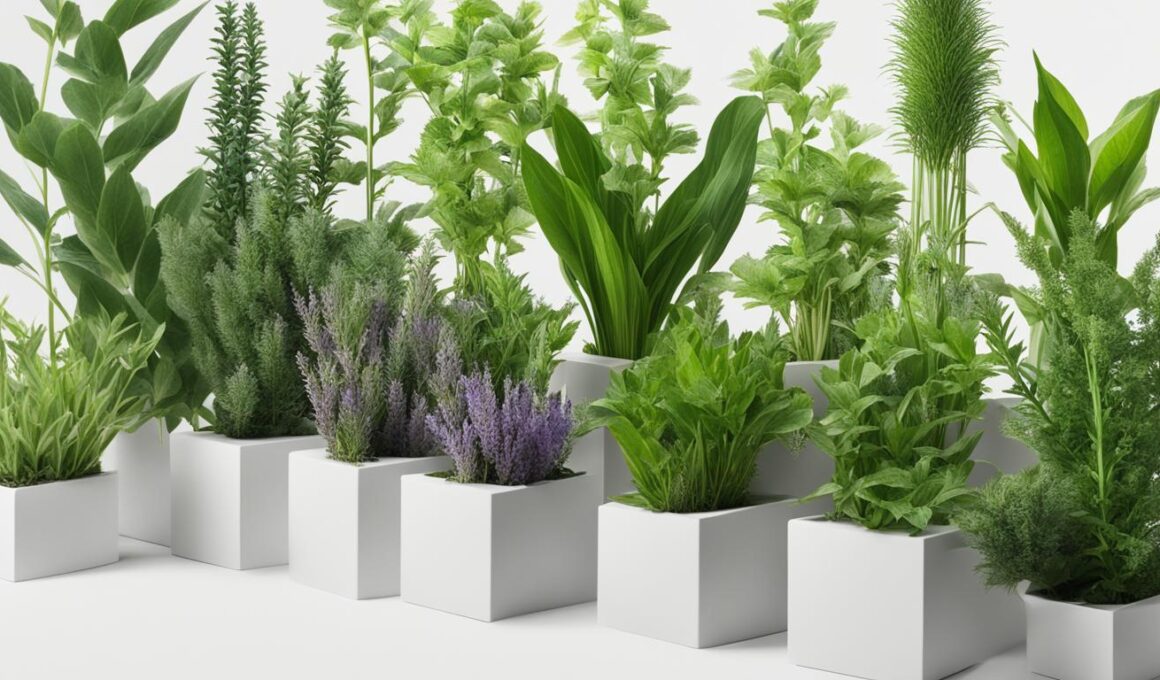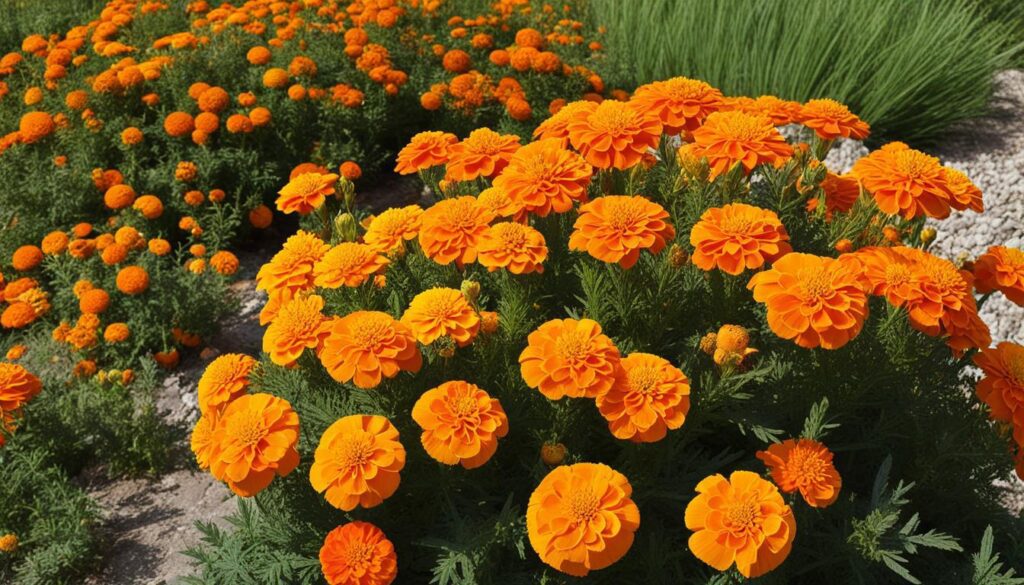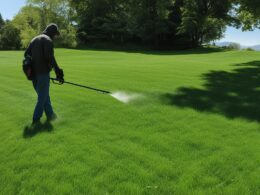Summer is the high season for fleas, but there are some plants that can naturally repel these pests. Adding these plants to your garden can help prevent flea infestations. Many of the plants that repel fleas are fragrant herbs, such as catnip, chamomile, citronella, chrysanthemums, eucalyptus, fleabane daisy, fleawort, lavender, lemon grass, marigolds, mint, rosemary, rue, sage, sweet bay, tansy ragwort, and wormwood. These plants produce fragrances or natural chemicals that fleas find unappealing. Placing these plants around your home can help keep fleas at bay.
Key Takeaways:
- Adding flea-repelling plants to your garden can help prevent flea infestations.
- Fragrant herbs like catnip, chamomile, and lavender can naturally repel fleas due to their fragrances and natural chemicals.
- Marigolds are not only beautiful flowers but also repel fleas and other pests like cabbage maggots and white flies.
- Plants from the mint family, like spearmint and peppermint, emit a sweet smell that repels fleas.
- Rosemary is not only a culinary herb but also an effective flea repellent due to its scent.
Catnip: A Natural Flea Repellent
Catnip is a plant that is highly effective at repelling fleas, making it a must-have for anyone with a cat. The plant produces a scent that is irresistible to cats but repels fleas.
By having catnip plants in your garden or even inside your home, you can help keep fleas away from your furry friends. Catnip is easy to grow and requires little maintenance. It can be planted in pots or directly in the ground, but make sure to keep it away from sensitive areas as cats may become territorial around catnip plants.
To enhance the efficacy of catnip as a natural flea repellent, you can also crush the leaves and sprinkle them in areas where your cat spends the most time, such as their bedding or favorite lounging spots.
Marigolds: A Multi-Functional Flower for Flea Repellent
Marigolds are not only beautiful flowers but also have the ability to repel fleas. These flowers emit a natural chemical called pyrethrum, which is known to repel fleas, ticks, and other insects.
Planting marigolds in your garden can offer multi-functional benefits, as they also repel other pests like cabbage maggots, white flies, and aphids.
Marigolds are relatively easy to grow and can be planted in both pots and garden beds. They thrive in full sun and well-drained soil.
Adding marigolds to your garden can provide both aesthetic appeal and natural flea repellent properties.
With their vibrant colors and multiple benefits, marigolds are an excellent choice for anyone looking to naturally repel fleas and other unwanted pests.
Mint: A Sweet-Smelling Flea Repellent
Mint plants, including various members of the mint family, such as spearmint and peppermint, emit a sweet smell that is overpowering for fleas. This makes them an effective natural flea repellent. Mint plants can be planted in pots or directly in the ground, both indoors and outdoors. They require regular watering and thrive in areas with ample sunlight.
The aroma of mint plants not only repels fleas but also adds a pleasant fragrance to your surroundings. Consider planting mint in areas where fleas are most likely to be present, such as near entrances or where your pets spend the most time.
Rosemary: More Than Just a Culinary Herb
Rosemary is an herb widely recognized for its culinary uses, but did you know that it can also be highly effective at repelling fleas? This fragrant herb emits an aroma that fleas find unpleasant, making it a natural deterrent for these pesky pests. Incorporating rosemary into your garden can not only enhance the taste of your dishes but also help prevent flea infestations.
Rosemary can be grown in pots or directly in the ground, making it a versatile plant that can thrive both indoors and outdoors. It requires a warm and dry environment, making it particularly suitable for certain regions. By planting rosemary in your garden, you can enjoy its culinary benefits while benefiting from its natural flea repellent properties.
In addition to repelling fleas, rosemary is also known to ward off ticks and other insects. Its aromatic properties make it a valuable addition to your pest control efforts. By strategically placing rosemary plants around your home, you can create a barrier against fleas and other unwanted visitors.
To make the most of rosemary’s flea-repellent qualities, consider using fresh sprigs or dried leaves to create sachets or natural flea sprays. These can be placed in areas frequented by your pets or near entrances to deter fleas from entering your home.
Remember, rosemary is just one of the many plants that can naturally repel fleas. Placing a variety of such plants in your garden can help create a natural barrier against these pests while adding beauty and fragrance to your outdoor space.
Benefits of Rosemary for Flea Repellent:
- Highly effective at repelling fleas
- Can be grown in pots or directly in the ground
- Thrives in warm and dry environments
- Repels ticks and other insects
- Enhances the taste of culinary dishes
- Can be used to create natural flea sprays or sachets
- Complements other natural flea-repellent plants
Conclusion
When it comes to preventing fleas, natural solutions can be both effective and environmentally friendly. By planting flea-repelling plants in your garden and strategically placing them around your home, you can create a natural barrier against these pests. The plants mentioned, such as catnip, marigolds, mint, and rosemary, emit fragrances or natural chemicals that fleas find unappealing. These plants can be easily incorporated into your existing garden or planted in pots for added flexibility.
Remember to choose plants that are safe for your pets and to avoid toxic plants. Regular maintenance and pest control treatments can further enhance the effectiveness of these natural flea repellents. By taking a proactive approach to flea prevention, you can enjoy a flea-free home while minimizing the use of chemicals.
So why resort to harsh chemicals when you have these natural flea repellents at your disposal? Not only do they help keep your furry friends and family protected, but they also add beauty and fragrance to your garden. With catnip, marigolds, mint, and rosemary on your side, fleas don’t stand a chance!
Can Plants That Repel Fleas Also Repel Caterpillars?
Yes, some plants like lavender, spearmint, and pennyroyal can be effective caterpillar pest control as well as flea repellents. These plants contain natural oils that repel both pests. Planting them in your garden can help protect your plants from caterpillar damage while also keeping fleas away.
FAQ
What are some natural flea repellents?
Some natural flea repellents include plants such as catnip, marigolds, mint, and rosemary.
How do these plants repel fleas?
These plants produce fragrances or natural chemicals that fleas find unappealing, which helps keep them away.
Can I plant these repellent plants in my garden?
Yes, you can plant these repellent plants in your garden to help prevent flea infestations.
Are these plants safe for my pets?
Yes, these plants are generally safe for pets, but it’s always a good idea to research the specific plant and consult with a veterinarian if you have any concerns.
Where should I place these plants to repel fleas?
It’s recommended to strategically place these plants around your home, such as near entrances or areas where your pets spend the most time.
How do I take care of these flea-repellent plants?
Each plant has specific care requirements, but in general, they thrive in areas with ample sunlight and well-drained soil. Regular watering and maintenance are also important.
Can I grow these plants in pots?
Yes, these plants can be grown in pots for added flexibility, allowing you to move them around as needed.
Can these plants repel other pests?
Yes, some of these plants, such as marigolds, are known to repel other pests like cabbage maggots, white flies, and aphids.
Are there any toxic plants I should avoid when repelling fleas?
While the plants mentioned in this article are generally safe, it’s important to research and avoid any toxic plants that could be harmful to your pets or humans.
Can these natural flea repellents replace other pest control treatments?
While these plants can help prevent flea infestations, it’s still recommended to use regular pest control treatments for maximum effectiveness.











